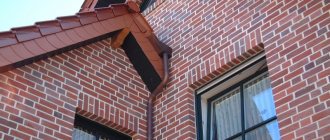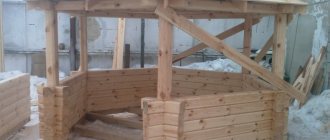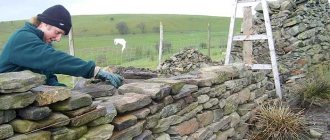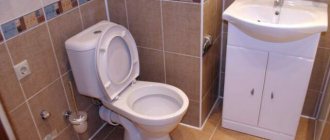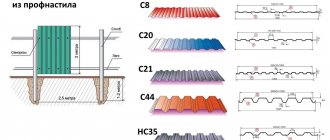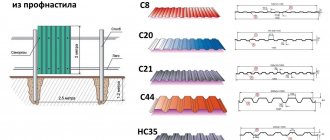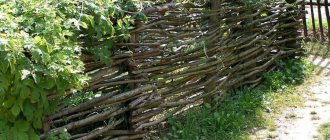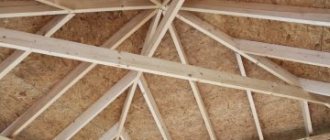Having a country house or dacha, one of the main points of arrangement is the installation of a reliable and durable fence, which will provide protection from intruders and the prying eyes of strangers.
A brick fence will perfectly cope with this function. You can build it yourself along the entire perimeter of the site or invite a team of craftsmen to help.
Read about other country houses:
- DIY brick barbecue oven
- How to make a brazier out of brick
What types of raw materials are best to use?
Since the material will be used exclusively for outdoor work, it is necessary to make the right choice in favor of bricks that are resistant to external influences. Let us examine in more detail the suitable types, their advantages and disadvantages.
Red
Consists of ordinary clay. It is fired at temperatures up to 8000 C. Depending on the purpose, it can be ordinary or front. By filling - hollow or solid.
Among the advantages:
- high strength;
- frost resistance;
- dense.
There are no significant shortcomings.
However, builders recommend plastering it after finishing the masonry. So, the fence will last even longer. But the finishing stage can be omitted if this contradicts the design idea.
Clinker
The production technology is similar to red, but the firing temperature is several times higher. Due to this, the clay sinteres better, acquiring greater strength.
Among the advantages:
- resistance to high humidity;
- does not lose properties under sudden temperature changes;
- durable.
The main disadvantage is the high price.
Silicate (white, yellow)
It will be the cheapest in terms of costs. It is made using an autoclave method from a mixture of sand and lime. Facial is available in three types:
- single;
- one and a half;
- double.
The last one is only hollow, the first 2 are hollow and solid.
Silicate of non-standard shape with rounded corners, curved lines, and a relief surface is popular.
In addition to the usual white color, it can be painted in other colors. But it is important to remember that the mixture must contain alkali-resistant mineral-based pigments. Any others will lead to damage to the raw materials.
A yellow brick fence looks good if you decorate it with contrasting tones of the material.
It is worth highlighting a type of torn or chipped stone, when there are many chips and cracks on the uneven surface.
The advantages are accessibility and low price. The cheapest in this category are white and gray silicate.
Flaws:
- low moisture resistance;
- susceptible to temperature changes;
- The strength is several times inferior to other types.
Facing
It received this name due to the fact that it is used for finishing the external parts of buildings, basements, walls, fences. The range of forms is great. Brick that imitates other materials is in demand.
In the color scheme, the most popular are yellow and its combination with brown. They are chosen for cladding facades and building fences.
In addition to the standard benefits, this type of brick does not need to be finished with plaster or painted. The material is initially completely aesthetic and ready for use.
With the exception of the high cost, no significant drawbacks were found.
Hyper-pressed
Such masonry raw materials are obtained from lime and cement. Has increased density. It will make it possible to build an expensive, but original and reliable fence.
Color spectrum:
- black;
- green;
- mocha;
- chocolate;
- grey.
If you have to chop a brick, the texture of natural stone will be visible on its cut.
The advantages and disadvantages of this material are identical to the previous type.
Thematic material:
- Fence made of brick and corrugated sheets
- Installing a fence with brick pillars
Brick laying
A reliable stone fence is built using the technology of forming the walls of a residential building. Here corner pillars are built, intermediate supports with a height of half to 0.7 meters are made, and piers are installed.
Experts lay out half-meter structures from rows into half a building block. The columns of the two-meter fence consist of two-row masonry, and the thickness of the pier corresponds to one stone. The blocks of erected pillars are tied with special wire to the wall elements.
Types and uses of garden rakesNew Year in the yard: how to beautifully decorate the yard with your own hands!
- How to make a modern landscape design with your own hands?
Builders pull the fishing line every 4-5 steps to detect relief defects on the surface. Before the solution has completely hardened, errors can be easily corrected by tapping the rubber tip of a hammer on a wooden strip.
To obtain the optimal thickness of the front side joints, you need to use special polyvinyl chloride frames. They equip the spaces between the main elements of the row being created.
After the cement has set, the bookmarks are eliminated, and the free space is covered with multi-colored mixtures. When performing work, the correct geometric shape of the row is observed, excess leaking solution is removed, and the front surface is thoroughly cleaned of adhering drops.
Types of barriers
The design of such structures involves using one raw material or combining 2-3 different ones.
Let's look at the features of each of them.
Monolithic
Owners of private houses often prefer a fence made of torn bricks with the addition of forged elements. Especially when it fits into the design of buildings. The pillars and base are made of dark-colored material, while the walls are made of lighter or brighter colors to give contrast. The foundation is a monolithic strip.
The solid brick structure serves for years, protecting the garden area from strong winds, bad weather, and unauthorized persons. This is a good option for aesthetics. But its construction takes a lot of time, labor and money. If you want to reduce the time it takes to create a fence project, then you should order the services of craftsmen. They will be able to calculate the required amount of material, draw up a cost estimate, and after receiving consent to begin construction, they will begin work.
Combined
If the selected combination weighs little, then a columnar base is sufficient. For fences with columns and a brick base, it is recommended to give preference to a monolithic strip fence.
To strengthen the structure, the supports can be reinforced with profile pipes. Jumpers are also made from them.
It is better to lay out the pillars from facing bricks. Caps made of steel, fiberglass, and concrete are put on top. The following are used as walls:
- block house;
- corrugated sheeting;
- picket fence (made of metal or wood);
- welded sections;
- forged parts;
- slate;
- polycarbonate;
- sheets of galvanized steel, iron.
In combined options it is easier to arrange a gate and wicket. Especially when it comes to sheet material (corrugated sheets, steel).
The forging at the top of the fence looks elegant. There are options for a white brick fence with natural stone inserts or welded parts.
Regardless of the chosen combination, it is important that the fence is a harmonious addition to the landscape design of the entire area.
Foundation construction
A fence built from natural or artificial stone blocks is distinguished by its high weight. Therefore, builders form the foundation according to the technological rules for producing brick buildings.
If geologists have discovered stone soil, a shallow, belt-type foundation can be constructed. On the remaining rocks, durable support piles are erected, to which a concrete strip is attached. The technology for constructing this type of foundation requires digging a trench 40-50 centimeters deep.
Recesses are made in the ditch, the underground level of which reaches 120-150 centimeters, and the bottom is equipped with gravel stones and a sand layer. Then, reliable waterproofing is created from a roofing material sheet 120 centimeters long and reinforcement, pre-welded from hot-rolled rods, is installed. Its height should ensure that this parameter of the rods in the well corresponds to the level of the planned fence posts.
The plane of the concrete surface is raised by installing formwork boards 20-30 centimeters high. The foundation filled with concrete is treated with a protective film and left alone for seven days, necessary for the fixing mixture to set.
When the low strength of the soil is unable to fully withstand a fence with brick pillars, the reinforcement structure can be replaced with a square pipe with walls 60 to 80 millimeters thick.
Recommendations for choosing the optimal fence thickness
It all depends on what functions are assigned to the structure.
If you want to lay out a fence solely for the purpose of decorating the area, then a thickness of half a brick will suffice. That is, the material is placed with the long side along the perimeter.
When a fence needs to be built to protect a site from the street and separate it from neighbors, the thickness of the material should be 1-2 bricks. In this case, the long side of the raw material is placed across the fence.
To calculate the required volume of bricks, you will need to know the total area, height, and thickness of the fence.
So, for 1 m2 of a fence with a masonry of 1 brick you will need about 100 pcs., for a masonry of 2 bricks - 200 pcs.
The height ranges from 0.5 m to 3.5 m. When calculating it, the requirements of current legislation should be taken into account.
Users often search for:
- At what distance from the house can you build a fence?
- Caps for brick fence posts
We analyze masonry options
When choosing any type, you should always consider 3 principles:
- Brick rows must be positioned strictly parallel to each other. In this case, the raw material will be subjected to minimal bending pressure and compressed to the maximum.
- In each row, the sides form precise longitudinal and transverse seams.
- As a result of observing the first two principles, a common seam is formed.
If all 3 recommendations were implemented in practice, then it means that the construction process was carried out with high quality, and the product will last for many years.
Let's take a closer look at the various masonry structures.
Bavarian
This technique appeared in Germany and then became popular in other countries. The facades of old German houses are laid out in this way.
Bavarian dressing involves mixing bricks of different colors without following any pattern.
Flemish
Used to form walls into one brick.
The peculiarity is that the tie and spoon elements are laid in one row. And in order for small protrusions to form in the corners, for this in the intermediate rows the material should be beaten into two halves and only one of them should be used.
The Flemish garden ligation pattern differs from the usual one in that in a row, after two spoon bricks, there is one interlocking brick.
English
The photo below shows an example of such masonry:
When arranging a suburban or summer cottage site, this type of masonry is in greatest demand because it is considered the most reliable. They are used when constructing retaining walls in a building.
It consists of alternating rows of bonded and spoon bricks. In this method, a vertical seam does not form on the structure.
When forming a butt row, chipped elements are used in the corners, due to which protrusions are formed.
In the version with a garden dressing, behind three rows of a spoon there is one splice.
Spoon
It is considered the simplest. Used for finishing work.
Spoon dressing or half-brick means that the elements in a row are shifted by 1/2 or ¼ of the length.
Possible problems and their solutions
The main problems that may arise after all construction work has been completed are related to the fact that the brick fence, made by hand, was not built at the masonry stage in stages and taking into account the above-listed features.
The most common problems are related to changes in size and “twisting”.
The top rows should in no case be wider than the bottom ones. It is necessary to constantly ensure that the width does not increase even by a millimeter, as this may subsequently lead to the collapse of the entire structure. Controlling the dimensions with one “everyday” level is not enough, since its error of several millimeters will not allow the error to be detected in time. In this case, it is better to use a tape measure, or create a bar yourself, with which you need to measure the row each time.
The “twisting” of the pillars is associated with the displacement of the pillar faces. In this case, the pillar itself “spins” around its axis. It is difficult to attach a span to such a pillar. Therefore, during work, it is necessary to constantly ensure that the corners of the rows are located strictly above each other. You can achieve perfection by attaching special corners.
Finishing the fence
It is recommended to install canopies made of metal or plastic on top of the posts.
You can add aesthetics to the fence using plaster or painting.
Plastering
It is not necessary to do this, but if the idea calls for it, then we do it in this order:
- We moisten the brick walls with water.
- Apply a 10–15 mm layer of plaster. Let it dry for an hour.
- Let's start leveling. We take a sharp rod and pass along the surface.
- Over the next 2 days, we moisten the coating to prevent cracks from appearing.
Painting
In this way, you can update an old brick fence or give a neat look to a new one.
Let's look at the technology for painting a new fence:
- We treat the surface with a primer. We pay special attention to the seams. We give it time to completely absorb.
- To apply the paint, we recommend using a thick brush. If one layer is not enough, then after it has dried, a second one should be applied.
- To complete the finishing, we treat the fence with a waterproof sealant from a spray bottle. This protective solution will make the surface more resistant to environmental influences.
Seam lines can be painted in contrasting colors.
Installing the backlight
A popular practice is to mount street lamps or lanterns to the fence. An original option is to install solar-powered bulbs in the shape of balls on fence posts that operate without electricity. And when evening comes, they light up with white light and illuminate the area.
If you decide to install standard outdoor lighting, we recommend that you seek help from an electrician who can safely connect the devices to the network and properly protect the connections from moisture.
Construction stages
All work that professional builders carry out during the preparatory processes and assembly of the structure is divided into four stages:
- In a specialized company or on the appropriate Internet resource, the design style of the fence is selected.
- Estimate documentation is carefully prepared, where the cost of consumables and services of qualified craftsmen is calculated, after which the construction of the wall is designed.
- A trench is dug to a certain depth, where a fairly reliable foundation is built for a brick fence.
- Blocks are laid on its structure, making up the main structure of the supporting pillars and enclosing walls.
The correct installation of decorative elements, lattice products, protective parts, and lighting devices occurs. The surface is treated with substances that slow down the loss of the characteristic shade and the destruction of baked clay.
Then the previously created surface is treated with a paint and varnish substance that is in harmony with the palette of all landscape components.
Photo gallery of finished fences
The photo below shows various ideas for brickwork and fencing design.
Creating a brick fence is a labor-intensive process that requires patience and construction skills. However, as a result, the owners receive a reliable and durable fence and an aesthetic appearance.
Marking the area
Marking the location of the future fence is done using small pieces of reinforcement or wooden pegs and a strong cord. Markers are driven in along the perimeter of the future foundation in increments of no more than one meter, and a cord is stretched between them.
For greater visibility, you can tie scraps of brightly colored fabric to the tops of rods or pegs, paint the tops, or place empty plastic bottles on them.
During the marking process, you must carefully monitor the parallelism of the lines and angles. Rotation of the fence is allowed only at a right angle, which can be checked using a straight edge. The locations of the pillars should be marked accordingly.

